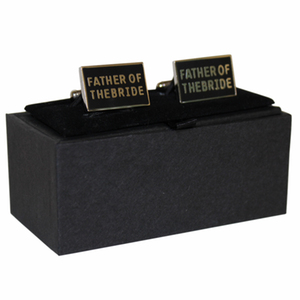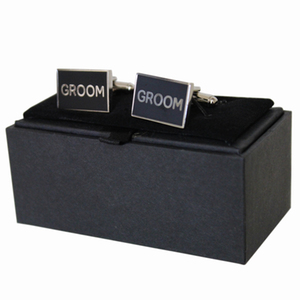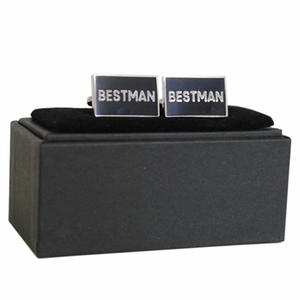
A little bit of History
A Very English Wedding
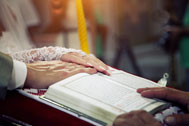 An English wedding is full of formalities and traditions which are steeped in history. Here are just a few of the main to help you unravel where our customs come from.
An English wedding is full of formalities and traditions which are steeped in history. Here are just a few of the main to help you unravel where our customs come from.The word Wedding comes from the Old English "weddian" meaning to promise, betroth or to marry or from "wedd" meaning a pledge.
The Night Before
The Wedding Day
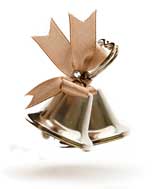 Church bells are rung as the couple enter to inform the community that the wedding is about to take place. Following the ceremony they peal a different tune to scare off evil spirits.
Church bells are rung as the couple enter to inform the community that the wedding is about to take place. Following the ceremony they peal a different tune to scare off evil spirits.The Wedding Dress
The white dress first became popular after Queen Victoria wore a white lace dress at her wedding to Prince Albert in 1840. The colour white is associated with virginity and purity which was linked to the reputation of the bride. The white gown became a symbol of status which middle-class English brides did not adopt fully until after World War.
Prior to Queen Victoria it was usual for royal brides to wear heavy brocaded gowns embroidered with white and silver thread.
In England it is traditional for the fabric of the wedding dress to be used to make the first child’s christening gown.
The Veil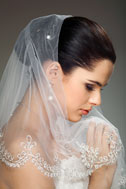 Until the19th century it was obligatory for women to wear veils in church. It was thought that the wedding veil was used as a symbol of social importance with the bride being too modest and well behaved to show their faces in public until they were married. However some historians believe that they may have been used to ward off evil spirits.
Until the19th century it was obligatory for women to wear veils in church. It was thought that the wedding veil was used as a symbol of social importance with the bride being too modest and well behaved to show their faces in public until they were married. However some historians believe that they may have been used to ward off evil spirits.
The most famous wedding dress in the world
The English wedding was given a significant boost on 29th July 1981, when three-quarter billion people watched Charles, Prince of Wales marry Diana Spencer in her ivory silk taffeta dress with a 25-foot-long train. This wedding is considered the most influential “white” wedding of the 20th century. The dress was designed by David and Elizabeth Emanuel and the woven silk taffeta used was made by Stephen Walters of Suffolk.
Kate’s Wedding Dress
English designer Sarah Burton, creative director of fashion house Alexander McQueen, designed the bridal gown worn by Catherine, Duchess of Cambridge (née Middleton), at her wedding to Prince William, Duke of Cambridge, on 29 April 2011.
Kate wished to combine tradition and modern style and she was inspired by the Victorian tradition of corsetry that Alexander McQueen was particularly known for.
The dress was made in ivory and white satin gazar, and had English Cluny lace from Ilkeston, Derbyshire for decoration. The bodice incorporated floral motifs cut from machine-made lace, which were then appliquéd on to silk tulle by workers from the Royal School of Needlework.
To fulfill the ‘something blue’ portion of the English wedding tradition, a blue ribbon was sewn inside the dress. The design for the bodice of the dress featuring lace in the style of the 19th Century was considered the ‘something old’
The Bridesmaids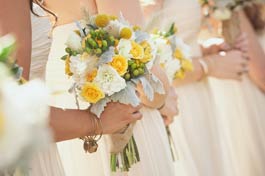
The Best Man
In ancient times, men sometimes captured women to make them their brides. A man would take along his strongest and most trusted friend to help him fight resistance from the woman's family. This friend, therefore, was considered the best man among his friends. In Anglo-Saxon England, the best man accompanied the groom up the aisle to help defend the bride.
In the past because weddings took place in the morning and gentlemen wore their morning attire, hence the ‘morning suit’. Morning suits are still used today for more formal weddings.
Music The wedding of Queen Victoria's daughter Victoria, to Prince Fredrick William of Prussia in 1858 introduced choral music to the ceremony when standard practice had been to have music of any kind only during a party afterwards.
The wedding of Queen Victoria's daughter Victoria, to Prince Fredrick William of Prussia in 1858 introduced choral music to the ceremony when standard practice had been to have music of any kind only during a party afterwards.
Giving Away The Bride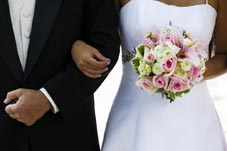 The tradition of the father giving away his daughter has its roots in the days of arranged marriages. Daughters in those times were considered their father's property. It was the father's right to give his child to the groom, usually for a price. Today a father giving away his daughter is a symbol of his blessing of the marriage.
The tradition of the father giving away his daughter has its roots in the days of arranged marriages. Daughters in those times were considered their father's property. It was the father's right to give his child to the groom, usually for a price. Today a father giving away his daughter is a symbol of his blessing of the marriage.
British wedding traditions state that the bride stands to the right of her Father leaving his sward arm free. They lead the procession, followed by the bridesmaids and pageboys.
However, it is becoming more common to send the bridesmaids in first, not only does it help build the excitement even more, but it gives the bride a few more moments alone with her father before making her grand entrance.
Where to stand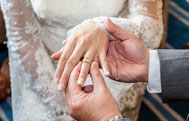 Traditionally the bride stands on the left of the groom during the marriage ceremony this was to allow his sword arm to be free ready to fight off other men who may want her as their bride.
Traditionally the bride stands on the left of the groom during the marriage ceremony this was to allow his sword arm to be free ready to fight off other men who may want her as their bride.
No rings should be worn aside from the engagement ring, worn on the right hand, leaving the wedding ring finger free. The engagement ring goes back on the left hand after the ceremony.
Order of service
An Example of a typical church order of service:
- Entrance of the Bride
- Welcome and Introduction by the celebrant
- Hymn
- Readings
- Sermon
- Exchange of Marriage Vows
- Prayers;
- Hymn
- The Signing of the register
- The Final Blessing Exit
For Good Luck
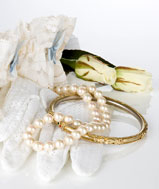 Following a Victorian tradition English brides are expected to wear or carry the following items on the day to ensure good luck throughout their married life.
Following a Victorian tradition English brides are expected to wear or carry the following items on the day to ensure good luck throughout their married life.These are defined by the rhyme:
Something old, something new,
Something borrowed, something blue,
And a silver sixpence in your shoe
Something Old:
Represents the link with the bride's family and the past. A common solution many brides choose is to wear a piece of family jewellery or their mother's or grandmother's wedding dress.
Something New:
Represents the newlyweds' happy and prosperous future together. The wedding dress is often chosen as the new item.
Something Borrowed:
To remind the bride that friends and family will be there for her when help is needed. The borrowed object might be something such as a lace handkerchief or an item of jewellery. The bride must return the item to ensure good luck.
Something Blue:
Represents constancy and loyalty and from biblical times when blue represented purity. Frequently the bride's garter is usually the blue item.
A Silver Sixpence in her Shoe:
Used to wish the bride wealth, both financial and happiness.
The sixpence has been linked with weddings since the reign of Elizabeth I. in those times the Lord of the Manor where the bride lived would present a sixpence as a wedding gift. It later became the custom for the bride's parent to give the coin as a dowry gift. It was not until Victorian times that the present day custom evolved to give a silver sixpence as a lucky charm to bring wealth and happiness to the married couple and the bride should put the coin in her left shoe.
The Horseshoe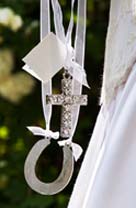 This is probably related to the legend associated with the 10th century St. Dunstan who trapped the Devil and as a result extracted a promise never to enter the house of a Christian, which he would recognise by a horseshoe hung above the door.
This is probably related to the legend associated with the 10th century St. Dunstan who trapped the Devil and as a result extracted a promise never to enter the house of a Christian, which he would recognise by a horseshoe hung above the door.
Hence the symbolism of the customary decorative "Lucky Horseshoe"; the Bride carries today upside down on her wrist. These days the horseshoes are rarely real, but instead light-weight versions manufactured specifically for weddings. The horseshoe is worn upside down so that the luck does not run out of the ends.
Wooden Spoons and Rolling Pins
The tradition of giving a wooden spoon or rolling pin dates back many years, these were considered to be the most useful utensils to be used in the kitchen and would be used to help the new Bride to cook the best meals for her new husband, and later her family.
These are now symbolically given to the bride decorated with lace and ribbon.
Confetti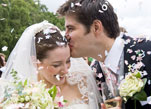 Rice was traditionally thrown at the bride and groom to encourage fertility. By the end of the 19th century, the English were increasingly using symbolic shreds of colored paper. Due to the concern about the mess this created this has since been replaced with coloured rice paper confetti or dried flowers.
Rice was traditionally thrown at the bride and groom to encourage fertility. By the end of the 19th century, the English were increasingly using symbolic shreds of colored paper. Due to the concern about the mess this created this has since been replaced with coloured rice paper confetti or dried flowers.
Chimney Sweep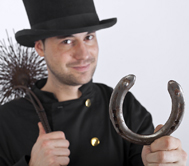 It is thought that the tradition of receiving a kiss from a chimney sweep would bring you good luck stems from an occasion when King George II's carriage horses bolted and the only person to attempt to stop them was a sooty figure of a man, a chimney sweep.
It is thought that the tradition of receiving a kiss from a chimney sweep would bring you good luck stems from an occasion when King George II's carriage horses bolted and the only person to attempt to stop them was a sooty figure of a man, a chimney sweep.
To ensure their good luck, some Bride and Groom's actually employ a chimney sweep to be present on their Wedding Day
The Celebrations
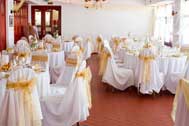
The Wedding Breakfast
The term Wedding Breakfast comes from a more ancient tradition of fasting before the wedding ceremony. As weddings were held in the morning food would not usually have been consumed before the ceremony, the Breakfast is therefore 'breaking that fast'
Wedding Cake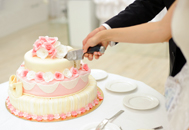 Wedding Cake is the traditional cake served at the wedding breakfast, following the ceremony. It is traditionally a fruit cake topped with marzipan and icing with three tiers the shape being associated with the spire of St. Bride's Church in the City of London. Viewed as a luxury item and a sign of social status, the cake was displayed as a centerpiece and an important part of the reception. The bigger the cake, the higher the social standing. Traditionally wedding cakes were made to bring good luck to all guests and the couple.
Wedding Cake is the traditional cake served at the wedding breakfast, following the ceremony. It is traditionally a fruit cake topped with marzipan and icing with three tiers the shape being associated with the spire of St. Bride's Church in the City of London. Viewed as a luxury item and a sign of social status, the cake was displayed as a centerpiece and an important part of the reception. The bigger the cake, the higher the social standing. Traditionally wedding cakes were made to bring good luck to all guests and the couple.
The earliest known sweet wedding cake is known as a Banbury cake which is a spiced, currant filled, flat pastry cake which is still made today although not for weddings! In Medieval England cakes were stacked as high as possible for the bride and groom to kiss over, if they successfully kissed over the stack they were guaranteed a prosperous life together.
In the early 19th century, Wedding cakes were becoming more popular as sugar become easier to obtain. The more refined and whiter sugars were still very expensive therefore only the wealthy families could afford to have pure white icing, and when Queen Victoria used this on her cake it became known as royal icing.
Originally the cake was distributed among the guests by only the bride because consuming the cake would ensure fertility. As the number of guests attending weddings increased, the groom needed to help the bride cut the cake and distribute it. Now the Bride and the Groom make the first cut in the cake together, symbolising their shared future. Then they cut a slice and share it between themselves before distributing it to the guests this symbolises their promise to forever provide for each other.
Traditionally the top tier of the wedding cake is saved for the birth of the first child and is used at their christening celebration hence the reason it is known as the christening cake.
The Bridesmaids kept their slices and placed them under their pillows on the night of the wedding in the belief that they will dream of their own future husbands
Wedding Favours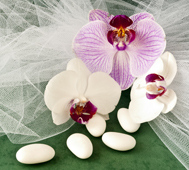 The tradition of giving guests something to remember the day by in the form of favours has been around for hundreds of years. Originally they were pastries or sweets in little pouches or boxes.
The tradition of giving guests something to remember the day by in the form of favours has been around for hundreds of years. Originally they were pastries or sweets in little pouches or boxes.
This evolved to giving each female guest at the wedding five prettily-wrapped almonds representing fertility, longevity, wealth, health and happiness. Female guests who could not attend would also be sent a favour from the Bride.
The modern wedding favour can be almost any sort of small gift or keepsake.
Speeches and Toasts
Traditionally, the speeches begin with the father of the bride, followed by the groom and finally the best man. On average, the speeches last for a total of 45 minutes
The toast is a ritual in which a drink is taken as an expression of honor or goodwill which is held at the end of each of the speeches
Putting one's glass down before the toast is complete, or simply holding one's glass without drinking is widely regarded as impolite, suggesting that one does not share the kindly sentiments expressed in the toast, nor the unity and fellowship implicit in toasting itself Even the non-drinker is advised to allow wine to be poured for a toast
Wedding Gifts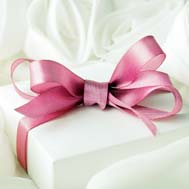 In years gone by, fruits were given to the married couple to encourage fertility. Today the use of bridal registries have become more popular where friends and family members pass around the bride and grooms general list of items they would like to receive.
In years gone by, fruits were given to the married couple to encourage fertility. Today the use of bridal registries have become more popular where friends and family members pass around the bride and grooms general list of items they would like to receive.
Wedding gifts are brought to the reception, or delivered directly to the couple before the wedding. Traditionally gifts are not opened until after the honeymoon.
The First Dance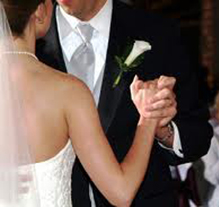 In the past, etiquette for formal balls dictated that the first dance was led by the guest of honor, which was usually the person of the highest social position in a given context,
In the past, etiquette for formal balls dictated that the first dance was led by the guest of honor, which was usually the person of the highest social position in a given context,
The wedding reception follows this custom and for this reason married couple as the guests of honor open the “first dance”. This is one of the most popular elements of a wedding reception.
Traditionally, the first dance was usually a waltz, however in the current times, ballroom dancing is less fashionable and is more commonly replaced by a ‘slow dance'.
The wedding bouquet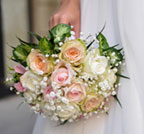 The first bouquets consisted of herbs, the practice probably originated from the time of the Plague, when people clutched the herbs over their noses and mouths in an effort to stave off germs. Later, orange blossoms and flowers were incorporated into the wedding ceremony as a symbol of fertility.
The first bouquets consisted of herbs, the practice probably originated from the time of the Plague, when people clutched the herbs over their noses and mouths in an effort to stave off germs. Later, orange blossoms and flowers were incorporated into the wedding ceremony as a symbol of fertility.
Traditionally, tossing the bouquet stems from a time when women used to try to rip pieces of the bride's dress and flowers in order to obtain some of her good luck. To escape from the crowd the bride would toss her bouquet and run away.
It is now customary for the bride to throw her bouquet backwards over her shoulder to the assembled group of unmarried women when she leaves for honeymoon. Folklore suggests the person who catches it will be the next to wed.
The Garter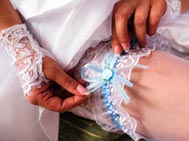 The wedding garter is possibly one of the oldest wedding traditions and dates back to the Dark Ages. After the celebrations, guests would accompany the bride and groom up to their bedroom and rip the clothes of the bride in order to help thee new couple along. In the process the garter which was used to hold up the brides stockings would get tossed and it was considered good luck for whoever caught it.
The wedding garter is possibly one of the oldest wedding traditions and dates back to the Dark Ages. After the celebrations, guests would accompany the bride and groom up to their bedroom and rip the clothes of the bride in order to help thee new couple along. In the process the garter which was used to hold up the brides stockings would get tossed and it was considered good luck for whoever caught it.
Over time it has evolved into a tradition which is the equivalent to the throwing of the wedding bouquet and has the groom throwing the bride's garter to the assembled unmarried men; the man who catches it is supposedly the next to wed and should place it on the left leg of the girl who caught the bouquet.
The Honeymoon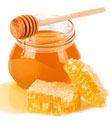 The term ‘honeymoon’ comes from the tradition where the bride would drink mead (a brewed, fermented drink made of honey) for one month after the wedding to encourage fertility.
The term ‘honeymoon’ comes from the tradition where the bride would drink mead (a brewed, fermented drink made of honey) for one month after the wedding to encourage fertility.
Across the Threshold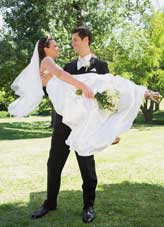 There are several legends as to why the groom carries the bride over the threshold; the two most common ones in England are as follows:
There are several legends as to why the groom carries the bride over the threshold; the two most common ones in England are as follows:
A new bride was particularly vulnerable to spirit intrusion, especially through the soles of her feet, therefore the groom would carry his wife into the house so that she would not bring any evil spirits inside with her
A bride who tripped over the threshold of her new home would bring bad luck to her marriage. Therefore, the groom carrying the bride into the home was a good way to avoid such an accident altogether.
Today, the groom carries his bride across the threshold as a romantic way to welcome her into his life.
Shop Here…
Accessories for Men
Select Your Currency:
